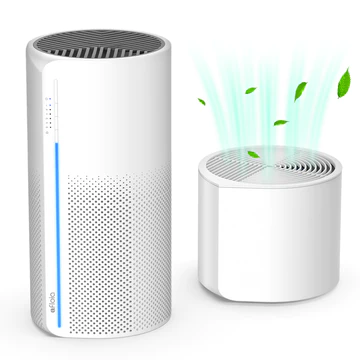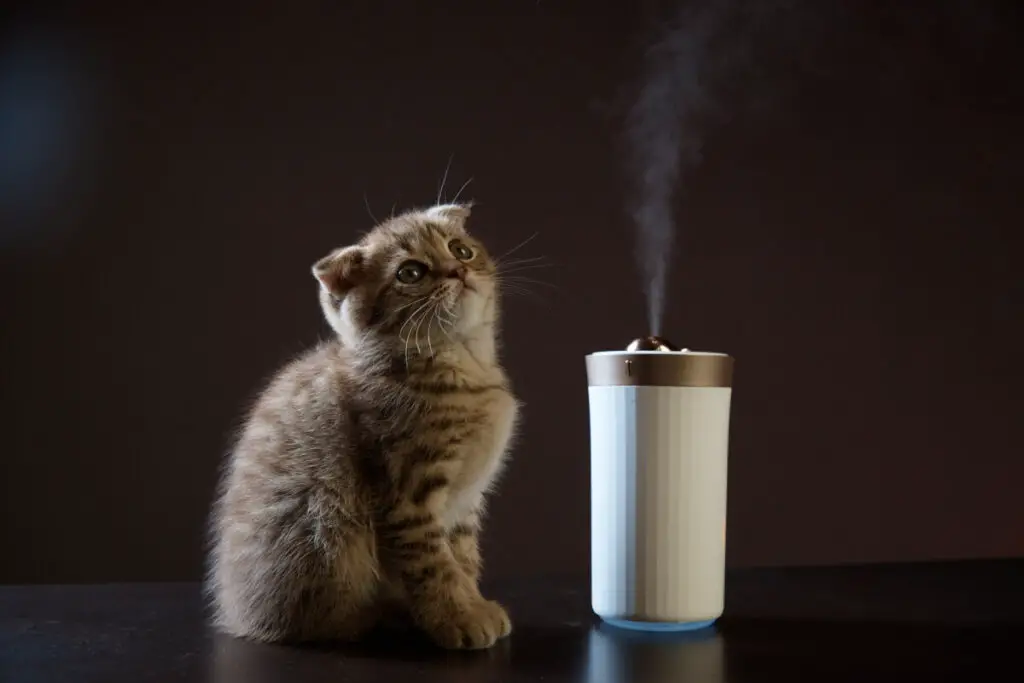More than one third of all Americans have a pet, yet a similar number of us have allergies to pets and their dander.
Humidifiers do not directly reduce pet dander. However, the correct levels of humidity (30-50%) can minimize pet allergy reactions by improving the efficiency of mucous lining in your nose and mouth. Air purifier-humidifier combination units that can effectively remove pet dander whilst also humidifying the air can help reduce the risk of allergic reactions.
This guide comprehensively explains all you need to know about humidifiers and pet dander, including how humidifiers help prevent pet allergies.
Pet Dander In Our Homes
Pet dander is the dead skin cells shed by furry animals, like cats, dogs, hamsters and rabbits.
These animals molt, which includes shedding their hair and cells. Once the dead fur and dander fall out, the growth of new hair, whiskers, and healthy skin can happen.
How often molting happens depends on the animal. Cats, for example, take up to 6 to 8 weeks to get rid of fur and dander, whereas dogs can molt once or twice a year, depending on the breed.
Apart from this larger primary cycle, animals also shed a smaller amount of hair and dander every day. Pet dander is microscopic and lingers in the air. Because of its small size, even air purifiers with generic filters cannot completely clear them out of our air.
In fact, HEPA filtration is the only way to successfully remove pet dander from the air.
But in places with high humidity (>50%) dander can settle on surfaces and stick to clothes, so less is in the air.
Humidity And Pet Dander
The primary purpose of humidifiers is to add moisture to the air. Humidifiers cannot specifically remove pet dander. Even though some units have filters, they are usually generic ones that do not trap particles as small as pet dander.
Only HEPA filters (pore size 0.3 microns) can remove dander particles. Humidifier filters are not fitted with HEPA and only filter out dust and large-sized impurities from the in-flow of air.
How A Humidifier Can Help With Pet Allergies
Pet allergies are an aggressive immune response triggered by dead animal cells, hair, or fluids. These contaminants are generally harmless, but some of us are sensitive to pet dander and develop an immune reaction to combat the allergen.
Extreme levels of moisture negatively impact pet allergies.
However, when maintained within ideal limits (30-50%), humidity can help keep allergies at bay.
When the air is dry, our skin, nose, and throat are devoid of moisture and become more prone to allergies from dander. Since people also tend to stay indoors in cold, dry weather, the risk of exposure to allergens also increases.
The right levels of humidity prevent dander from reaching the throat and lowers the rate of skin allergies.
To get the benefits of humid air you would need to invest in an appropriate-size humidifier for your home and set your desired humidity level between 30 and 50% – definitely not higher.
In fact, the Environmental Protection Agency (EPA) says it’s ideal to maintain relative humidity below 60% in summer, and in the range of 25-40% in winter.
When To Use A Humidifer For Pet Dander
Humidifiers are almost essential for those of us living in dry climates, but are practically useless if you live in the tropics, like Florida.
When humidity levels are low, it’s better to run a humidifier constantly on auto mode. In the automatic mode, the humidifier periodically switches on and off to keep the humidity from rising above (or falling below) the set point.
However, if you don’t want to run the unit 24/7, it is generally best to run it at night because, after the temperature drops at night, the humidity levels also fall below the ideal levels (30-50%).
Pet allergies also tend to worsen at night – because pet dander is frequently found in our mattresses (yuck!). Since humidifiers help lower the risk of allergies, it can be ideal to have them running throughout the night.
How High Humidity Affects Pet Dander
High humidity does not accelerate or decrease the shedding of pet dander.
However, excessive humidity has adverse effects in terms of pet allergies. If high humidity levels are left unchecked, the moisture can cause the pet dander to stick to our surfaces and clothes.
This increases the chances of exposure to the allergen, and consequently, the risk of immune reaction also rises. Adding to this, damp air also favors growth of molds, insects and dust mites, exacerbating pet allergy symptoms in conjunction with other allergens.
How A Dehumidifier Affects Pet Dander
A dehumidifier can help prevent animal dander from settling down, improving the chances of it being removed by an air purifier. However, a dehumidifier on its own does not reduce the concentration of pet dander in the air.
In an excessively humid environment, pet dander sticks to surfaces and becomes challenging to remove with an air purifier.
Dehumidifiers remove the excess moisture from the air and bring the humidity levels down to an optimal range. This makes them more suitable for humid environments, where the humidity is greater than 60%.
They do not directly influence the shedding process in any way. But dehumidifiers can dry the environment, preventing the dander from settling and sticking to surfaces and clothes.
The dehumidification allows the pet dander to float in the air, and you can then rely on an air purifier to filter and remove it.
Humidifier And Air Purifier Combos
While a humidifier alone can’t remove pet dander, 2-in-1 air purifier and humidifiers combo units can. These combination products are an emerging trend and here’s why they can be good choice:
- Air purifiers are designed exclusively to sanitize the air. While you can buy a humidifier with a filter, it can’t remove pet dander.
- Most air purifiers come with a HEPA filter that traps dander and other microscopic pollutants. With this, you can stay assured of 99.97% removal of dander floating in your air.
- Apart from dander, pet odor can also be irritating. It stems from animal fur, urine, and skin and can be unpleasant. Buying an air purifier with an activated carbon filter counters this issue. It adsorbs unwanted pet smells and, in this way, helps minimize pet allergies.
- While air purifiers clear the air of impurities, the humidifier regulates the moisture content in the room, allowing you to live in a comfortable environment.
- The combination units are more economical and compact in comparison with individual appliances. Another plus is that some of them are also capable of running independently of one another.
Our favorite air purifier-humidifier combo is from Afloia.
Afloia 2 in 1 Air Purifier and Humidifier MIRO PRO

The Afloia MIRO PRO is one of the best options you can find for an air purifier and humidifier combo. It’s mainly an air purifier featuring HEPA filtration, which effectively removes floating pet dander.
The HEPA filter used in the device is Medical Grade 13, which guarantees 99.95% efficiency in filtering out particles as small as 0.3 microns. Not only that, but the unit also has a pre-filter that removes large particles to keep the HEPA filter clean. With these filters, the appliance removes pet odors, dander, and hair.
It is capable of cleaning 220 sq. ft. of air at an incredible rate of five times per hour, meaning you should notice a visible difference in air quality just 20-30 minutes after turning it on.
The filtration also prevents any impurity from entering the humidifier located at the base of the air purifier. It employs evaporative humidification to moisten the air, which dispenses clean, humid, and mist-free air into the room.
You can detach the humidifier by removing the module from the unit, and the air purifier will continue working without it. Since the main body is an air purifier, the humidifier cannot operate independently.
The appliance also has a seven-color light feature that can improve the aesthetics of the room.
Why Pet Dander Can Be Harmful
Animal dander isn’t considered a contaminant, but it’s an allergy source for people with a sensitive immune system. According to the Asthma and Allergy Foundation, 3 in 10 people in the US are allergic to pets, with dander as a primary trigger.
These allergies are mainly associated with cats and dogs.

Although allergies due to cat dander are more common, dogs’ fur and dead skin flakes can cause more severe reactions.
Here are some of the possible complications of pet allergies caused by dander:
- It causes difficulty in breathing and, in severe cases, can lead to a decline in lung function.
- Pet dander can inflame the sinuses, increasing the facial pressure, which results in headaches and pain in the face.
- Inflammation consequently obstructs the sinuses, causing nasal congestion.
- The blocked sinuses leave a person prone to bacterial infections.
- Due to the allergic reaction, a person may develop hay fever.
- Rashes and itching are common, especially around the nose and in the upper chest region.
Because it’s microscopic and lightweight, dander is difficult to remove. It stays suspended in the air for an extended period (six months). To remove it effectively, proper grooming of the pet, maintenance of animal’s hygiene, regular cleaning, HEPA filtration, and anti-allergen sprays are crucial.
Although dander allergies are treatable with nasal sprays and oral medications, they are recurring, so necessary preventive measures should be in place.
